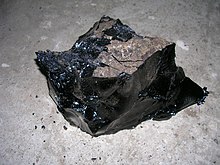
Bitumen
Form of petroleum primarily used in road construction / From Wikipedia, the free encyclopedia
Dear Wikiwand AI, let's keep it short by simply answering these key questions:
Can you list the top facts and stats about Bitumen?
Summarize this article for a 10 years old
Bitumen (UK: /ˈbɪtjʊmɪn/, US: /bɪˈtjuːmən, baɪ-/)[1] is a sticky, black, highly viscous liquid or semi-solid form of petroleum. In the U.S., it is commonly referred to as asphalt. It may be found in natural deposits or may be a refined product, and is classed as a pitch.[2] Before the 20th century, the term asphaltum was also used.[3] The word is derived from the ancient Greek ἄσφαλτος ásphaltos. The largest natural deposit of bitumen in the world, estimated to contain 10 million tons, is the Pitch Lake in southwest Trinidad.[4]



The primary use (70%) of bitumen is in road construction,[5] where it is used as the glue or binder mixed with aggregate particles to create asphalt concrete. Its other main uses are for bituminous waterproofing products, including production of roofing felt and for sealing flat roofs.[6]
In material sciences and engineering, the terms "asphalt" and "bitumen" are often used interchangeably to mean both natural and manufactured forms of the substance, although there is regional variation as to which term is most common. Worldwide, geologists tend to favor the term "bitumen" for the naturally occurring material. For the manufactured material, which is a refined residue from the distillation process of selected crude oils, "bitumen" is the prevalent term in much of the world; however, in American English, "asphalt" is more commonly used. To help avoid confusion, the phrases "liquid asphalt", "asphalt binder", or "asphalt cement" are used in the U.S. Colloquially, various forms of asphalt are sometimes referred to as "tar", as in the name of the La Brea Tar Pits.[7]
Naturally occurring bitumen is sometimes specified by the term "crude bitumen". Its viscosity is similar to that of cold molasses[8][9] while the material obtained from the fractional distillation of crude oil boiling at 525 °C (977 °F) is sometimes referred to as "refined bitumen". The Canadian province of Alberta has most of the world's reserves of natural bitumen in the Athabasca oil sands, which cover 142,000 square kilometres (55,000 sq mi), an area larger than England.[10]